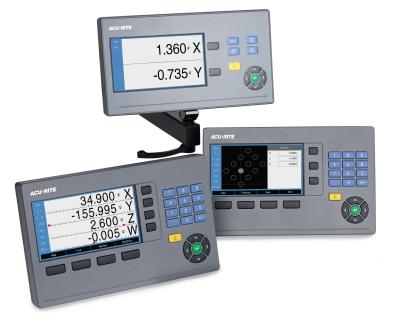
HEIDENHAIN’s ACU-RITE brand of digital readout (DRO) products for the machine tool marketplace has introduced a line of three innovative DROs with new software features and robust hardware, which is reportedly making a difference for milling, turning, grinding and boring applications.
Models DRO100/203/300 all support many new innovative software features, including an “Installation Guide” that appears at first-time power up that all DRO users will appreciate.
The DRO100 unit has been designed as a functional yet simple digital readout that can be easily understood by the operator.
The DRO203 offers all the basic functions of the entry level DRO100 plus common features for both milling and turning applications, such as bolt-hole calculations for milling and vectoring/ taper ratio for turning.
And the DRO300 high-end model provides even greater functionality. It is available in 3- and 4-axis variants and is programmable. The DRO300 is the only unit offering the connector for external switchiing functions. One completely new innovation is the option of expanding the DRO300 to servie as a 6-axis digital readout.
Some overall new features on these DROs include the “Dynamic Zoom,” where once activated, the display values for the axis currently being moved are maximally enlarged. The user can immediately see which axis is currently in motion.
Other new software features common to all include improved file management where users can save and/or load firmware, configuration files, graphic files and instruction manuals. Also, a simpler user management system has been introduced, and up to nine users can operate the DRO203 and DRO300 units.
Contact Details
Related Glossary Terms
- boring
boring
Enlarging a hole that already has been drilled or cored. Generally, it is an operation of truing the previously drilled hole with a single-point, lathe-type tool. Boring is essentially internal turning, in that usually a single-point cutting tool forms the internal shape. Some tools are available with two cutting edges to balance cutting forces.
- gang cutting ( milling)
gang cutting ( milling)
Machining with several cutters mounted on a single arbor, generally for simultaneous cutting.
- grinding
grinding
Machining operation in which material is removed from the workpiece by a powered abrasive wheel, stone, belt, paste, sheet, compound, slurry, etc. Takes various forms: surface grinding (creates flat and/or squared surfaces); cylindrical grinding (for external cylindrical and tapered shapes, fillets, undercuts, etc.); centerless grinding; chamfering; thread and form grinding; tool and cutter grinding; offhand grinding; lapping and polishing (grinding with extremely fine grits to create ultrasmooth surfaces); honing; and disc grinding.
- milling
milling
Machining operation in which metal or other material is removed by applying power to a rotating cutter. In vertical milling, the cutting tool is mounted vertically on the spindle. In horizontal milling, the cutting tool is mounted horizontally, either directly on the spindle or on an arbor. Horizontal milling is further broken down into conventional milling, where the cutter rotates opposite the direction of feed, or “up” into the workpiece; and climb milling, where the cutter rotates in the direction of feed, or “down” into the workpiece. Milling operations include plane or surface milling, endmilling, facemilling, angle milling, form milling and profiling.
- turning
turning
Workpiece is held in a chuck, mounted on a face plate or secured between centers and rotated while a cutting tool, normally a single-point tool, is fed into it along its periphery or across its end or face. Takes the form of straight turning (cutting along the periphery of the workpiece); taper turning (creating a taper); step turning (turning different-size diameters on the same work); chamfering (beveling an edge or shoulder); facing (cutting on an end); turning threads (usually external but can be internal); roughing (high-volume metal removal); and finishing (final light cuts). Performed on lathes, turning centers, chucking machines, automatic screw machines and similar machines.

